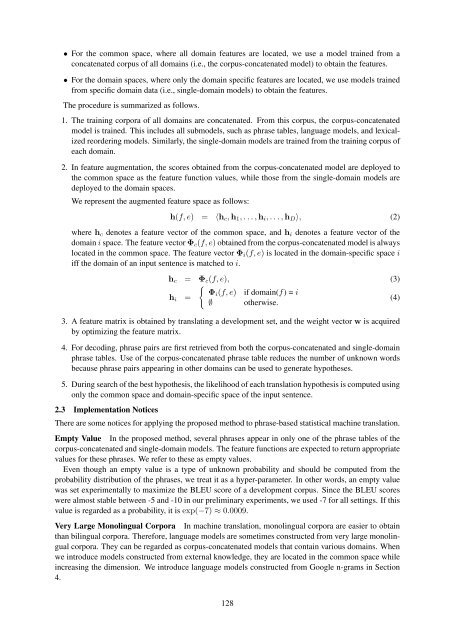December 11-16 2016 Osaka Japan
W16-46
W16-46
Create successful ePaper yourself
Turn your PDF publications into a flip-book with our unique Google optimized e-Paper software.
• For the common space, where all domain features are located, we use a model trained from a<br />
concatenated corpus of all domains (i.e., the corpus-concatenated model) to obtain the features.<br />
• For the domain spaces, where only the domain specific features are located, we use models trained<br />
from specific domain data (i.e., single-domain models) to obtain the features.<br />
The procedure is summarized as follows.<br />
1. The training corpora of all domains are concatenated. From this corpus, the corpus-concatenated<br />
model is trained. This includes all submodels, such as phrase tables, language models, and lexicalized<br />
reordering models. Similarly, the single-domain models are trained from the training corpus of<br />
each domain.<br />
2. In feature augmentation, the scores obtained from the corpus-concatenated model are deployed to<br />
the common space as the feature function values, while those from the single-domain models are<br />
deployed to the domain spaces.<br />
We represent the augmented feature space as follows:<br />
h(f, e) = ⟨h c , h 1 , . . . , h i , . . . , h D ⟩, (2)<br />
where h c denotes a feature vector of the common space, and h i denotes a feature vector of the<br />
domain i space. The feature vector Φ c (f, e) obtained from the corpus-concatenated model is always<br />
located in the common space. The feature vector Φ i (f, e) is located in the domain-specific space i<br />
iff the domain of an input sentence is matched to i.<br />
h c = Φ c (f, e), (3)<br />
{<br />
Φi (f, e) if domain(f) = i<br />
h i =<br />
(4)<br />
∅ otherwise.<br />
3. A feature matrix is obtained by translating a development set, and the weight vector w is acquired<br />
by optimizing the feature matrix.<br />
4. For decoding, phrase pairs are first retrieved from both the corpus-concatenated and single-domain<br />
phrase tables. Use of the corpus-concatenated phrase table reduces the number of unknown words<br />
because phrase pairs appearing in other domains can be used to generate hypotheses.<br />
5. During search of the best hypothesis, the likelihood of each translation hypothesis is computed using<br />
only the common space and domain-specific space of the input sentence.<br />
2.3 Implementation Notices<br />
There are some notices for applying the proposed method to phrase-based statistical machine translation.<br />
Empty Value In the proposed method, several phrases appear in only one of the phrase tables of the<br />
corpus-concatenated and single-domain models. The feature functions are expected to return appropriate<br />
values for these phrases. We refer to these as empty values.<br />
Even though an empty value is a type of unknown probability and should be computed from the<br />
probability distribution of the phrases, we treat it as a hyper-parameter. In other words, an empty value<br />
was set experimentally to maximize the BLEU score of a development corpus. Since the BLEU scores<br />
were almost stable between -5 and -10 in our preliminary experiments, we used -7 for all settings. If this<br />
value is regarded as a probability, it is exp(−7) ≈ 0.0009.<br />
Very Large Monolingual Corpora In machine translation, monolingual corpora are easier to obtain<br />
than bilingual corpora. Therefore, language models are sometimes constructed from very large monolingual<br />
corpora. They can be regarded as corpus-concatenated models that contain various domains. When<br />
we introduce models constructed from external knowledge, they are located in the common space while<br />
increasing the dimension. We introduce language models constructed from Google n-grams in Section<br />
4.<br />
128



